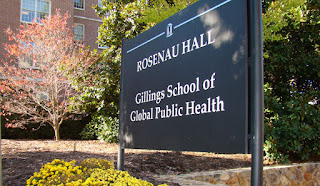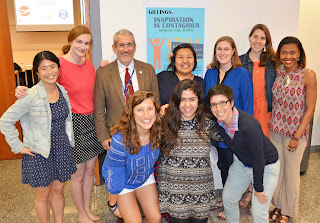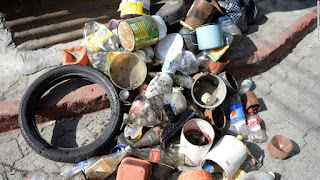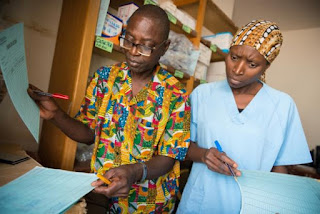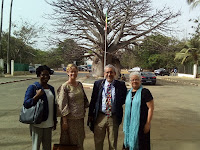 |
| Ghanaian King in procession |
Travel Dates - 23-27 April 2017
I traveled to Ghana for the purpose of exploring research opportunities for UNC Gillings faculty and practicum possibilities for students. Similar in size to the state of Oregon, Ghana is a West African country with an estimated population of 28 million (2016), about 48% of whom are under age 20 and a 2.15% population growth rate. The capital, Accra, is a port city of 2.27 million or 8% of the total population. Other major cities include Kumasi (1.5 million), Tamale (361,000), Takoradi (233,000), Achiaman (203,000), and Tema (156,000) through which the prime meridian passes at 0 degrees longitude.
 |
| Oil and gas fields along Ghanaian coast |
Ghana is important to U.S. government interests, with U.S. 2016 overseas development assistance (ODA ) funding at $146 million[1], its rich natural resources, stable government (seven peaceful democratic transitions) and increasingly strong economic growth (8.7% GDP in 2012).
Developed in 1995, the "Ghana Vision 2020" plan intends for Ghana to be the first African nation to become a developed country by 2029 and a newly industrialized country by 2039. This would seem to be on track, according to the World Bank, as GNI per captia [2] in Ghana has increased 428% from $280 in 2002 to $1480 in 2015.
Currently, over 70% of Ghanaian exports come from crude oil (28%), gold (23%), and cocoa beans (23%) which together generated $7.4 billion in export revenue in 2014 [3]. Regarding cocoa, according to the Ghana Cocoa Board, the cultivation of this cash crop employees 800,000 farm families in six of the ten Ghanaian regions and produces about $2 billion in foreign exchange annually.
 |
| IMR 1960-2015 Ghana |
According to UNICEF's most recent Multiple Indicator Cluster Surveys (MICS), Ghana has made very strong progress in basic health and economic indicators during the past two decades. For example, there has been a 39% and 44% decline in under-one and under-five mortality rates, respectively, between 1990 and 2012. Immunization rates in 2012 for DPT3 and Polio3 are at 92% and 91%, respectively, and the total fertility rate that has declined by 30% from 5.6 births per woman since 1990 to 3.9 births in 2012. About 34% of the population of reproductive age used modern contraceptives and adult HIV+ prevalence was 1.4% in 2012. These strong health indicators portend success for Ghana to become a developed nation in 12 years, following the Vision 2020 plan.
Research, Teaching, and Service
Ghana offers numerous research, training, and service opportunities that may be attractive to UNC school of public health faculty and students in an environment supportive of the UNC Gillings school mission to address “big public health problems with scalable solutions."
University of Ghana - Legon
The Noguchi Memorial Institute for Medical Research (NMIMR) was established in 1979 with
support from Japan as a semi-autonomous institute of the University of Ghana. As the major biomedical research facility in Ghana, the Institute is committed to research on
Ghanaian health priorities and training of biomedical scientists from Ghana and West Africa. I met with Institute Director, Professor Kwadwo A. Koram [email: KKoram@noguchi.ug.edu.gh], who indicated the Institute has enjoyed long-standing academic partnerships with Yale University (soil helminths research), University of Copenhagen (25 years joint training programs), the Swiss Tropical Institute (supports PhD training), the University of Sussex (implementation science, evidence to policy and practice, barriers to service delivery), and the WHO TDR Special Programme for Research and Training in Tropical Diseases (currently sponsors 6 post-doc Fellows ).
The Institute has traditionally focused on infectious diseases that were most prevalent in Ghana, e.g., malaria, HIV, the neglected tropical diseases (NTDs), and mycobacterial infections, and following traditional funding sources and international engagement in these areas. However, according to Director Koram, the Institute is now shifting its research efforts to reflect the epidemiological and demographic changes underway in Ghana. Increases in chronic diseases, such as diabetes, other kidney diseases, and breast, cervical, and prostate cancers are being observed in the Ghanaian population. The interface between infectious and non-communicable diseases complicates this dynamic. Given the rich flora of Ghana, the Institute is also increasingly focused on the area of medicinal plant research.
The Institute has departments of epidemiology, nutrition, histopathology, electron microscopy, parasitology, immunology,
 |
| Lab facilities at NMIMR |
Professor Koram introduced me to Dr. Daniel Kojo Arhinfu [email: DArhinful@noguchi.ug.edu.gh], immediate past head, Dept of Epidemiology (2009-2013) at the Institute, whose research interests include social health insurance, access to medicines and health commodities, maternal and child health, health systems, and the chronic disease burden in African populations. Kojo shared with me a few of his recent publications including: Health Facilities Survey in Ghana, Household Survey to Measure Access to and Use of Medicines in Ghana, Knowledge, Attitudes, Behavior, and Practices study on Low Generics Prescribing in Ghana.
The Institute has a strong Institutional Review Board (IRB), established in 2000, which is an independent body that ensures the protection of human subjects and ethical treatment of animals. The IRB serves the Institute, the school of nursing, the school of public health, the school of allied health, the medical school, and private organizations, on demand.
Historically, the Institute is named for Japanese scientist, Dr. Hideyo Noguchi, a bacteriologist who in 1911, while working for the Rockefeller Institute for Medical Research, discovered the spirochete bacterium Treponema pallidum as the infectious agent of syphilis. In 1926, Noguchi joined the British Medical Research Institute in Accra, the Gold Coast, as a member of the Rockefeller Yellow Fever Commission in West Africa. Unfortunately, two years later, in 1928, Noguchi died at age 51 from yellow fever which he believed, incorrectly, was caused by a bacillus. It was Max Theiler, a South African, who determined in the 1930s that yellow fever was the result of a viral infection, a discovery for which Theiler was awarded the Nobel Prize in 1951 for his development of a yellow fever vaccine.
Ghana School of Public Health
I had the pleasure to meet with School of Public Health (SPH) Dean and Professor Richard Adanu [email: rmadanu@ug.edu.gh] who warmly welcomed me to his office to share ideas about research opportunities and student and faculty engagement from University of Ghana and UNC Chapel Hill. The Ghana
 |
| Ghana School of Public Health campus |
- Biological Basis of Public, Environmental and Occupational Health
- Epidemiology and Disease Control
- Health Policy, Planning and Management.
- Population, Family and Reproductive Health
- Social and Behavioral Sciences
Institute for Statistical, Social, and Economic Research (ISSER)
In order to learn about local survey research opportunities in Ghana, I met with Dr. Issac Osei-Akoto [email: ioseiak@ug.edu.gh] Senior Research Fellow and Head, Statistics and Survey Division at ISSER. Issac has worked closely with UNC faculty, including Gillings Maternal and Child Health Department faculty member Kavita Singh on an evaluation of a maternal and newborn health project in Ghana, as well as with UNC School of Social Work's Gina Chowa on a youth savings project funded by the Mastercard Foundation.
 |
| ISSER facilities |
Electronic waste or e-waste may be of particular interest to students in environment sciences, health behavior, and health
 |
| Truck overloaded with E-waste |
As background on ISSER, the institute "was established in 1962 as the Institute of Statistics to provide a programme of teaching and research in statistics. In 1969, it was reorganized and renamed the Institute of Statistical, Social and Economic research with an expanded mandate to conduct research in the social sciences in order to generate solutions for national development. ISSER currently serves as the research wing under the College of Humanities, University of Ghana." ISSER also convenes the IRB for humanities studies and currently hosts 22 research fellows and has served as a consultant group to UNICEF and the Ghanaian Health Service, among others.
USAID and CDC
During my visit to Accra, I was warmly welcomed at the U.S. Embassy by Dr. Akua Kwateng-Addo [email: akwateng-addo@usaid.gov], USAID Health Office Director, and her colleagues, USAID Presidents Malaria Initiative (PMI) Resident Adviser, Mr. Sixte Zigirumugabe [email: szigirumugabe@usaid.gov], and CDC Country Director, Dan Baden, MD, [email: aix2@cdc.gov]. Overall, my takeaway from our discussion was all three Ghanaian institutions described above have been strong and reliable partners for the USG. Akua emphasized that Ghana also benefits from 4 excellent research centers located across the country, including the Kintampo Research Center, Navrongo Health Research Center, Dodowa Health Research Center, and Kumasi Centre for Collaborative Research. Ghana's strong national health insurance scheme has been in place for over 12 years and covers about 40% of Ghanaians. It is viewed as a model in sub-Saharan Africa and widely studied as a harbinger for other economically emergent Africa countries and attracts health economics researchers from across the globe.
Regarding the future of overseas development assistance (ODA) in Ghana, in concert with the Vision 2020 plan and the current and projected GDP growth, Ghana is likely to see fewer bilateral donors in the next decade. That being said, increased private investment and government funding of public health programs will need to offset reduced ODA, thus changing the donor landscape in the emerging economy of Ghana.
UNC Gillings Faculty Active in Ghana
Gillings has a number of faculty with research experience in Ghana, including Clare Barrington, Rohit Ramamswamy, Heidi Reynolds, and Ilene Speizer. A snapshot of their work is available from the Elsiever REACH NC mapping product by selecting Ghana on the map, as shown on this screenshot below.
 |
| REACH NC map |
Akwaaba (Welcome) to Ghana!
Jim
[1] http://beta.foreignassistance.gov/explore
[2] GNI is calculated using the Atlas method https://datahelpdesk.worldbank.org/knowledgebase/articles/378832-the-world-bank-atlas-method-detailed-methodology
[3] http://atlas.cid.harvard.edu/explore/tree_map/export/gha/all/show/2014/















